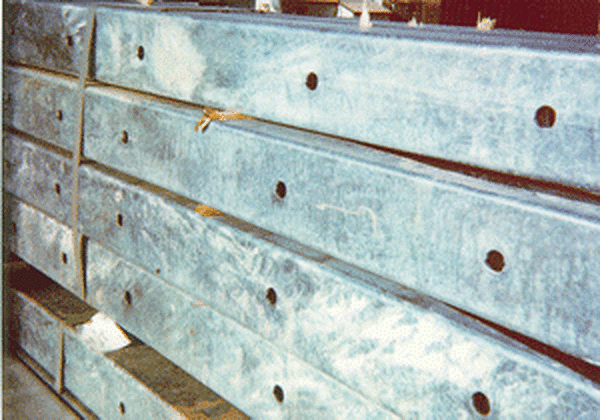Trucking/Transport of HDG Steel in Winter
How does one avoid wet storage stain during trucking?
Wet storage stain can tend to develop more frequently in the winter months due to rain, snowfall, fog and temperatures falling below the dew point, which encourages the formation of white corrosion products on the hot-dip galvanized surface. In the same time period, many roads and bridges throughout North America are exposed to deicing salts and chemicals (sodium chloride, magnesium chloride, calcium chloride, etc.) to keep roads and bridges free from hazardous amounts of snow and ice. The use of deicing salts and chemicals results in either wet roads containing concentrated saltwater, or a large amount of dry salts which both can be deposited on hot-dip galvanized products during transportation via flatbed trucking.

In the absence of excessive heat and moisture, galvanized steel performs very well in the presence of dry salts (hence its continued use for corrosion protection of dry salt storage facilities). However, if road salts or salty water are allowed to collect on the galvanized parts during transport in combination with exposure to high-humidity winter weather, it is reasonable to expect the galvanized coating to develop wet storage stain at an accelerated rate in areas where saltwater or salty snow can accumulate. Under these conditions, wet storage stain is commonly encountered as dark gray and/or white powdery corrosion products on the surface. This appearance can become more pronounced with the use of plastic wrappings or shrink films.
For short durations of transportation, the presence of this wet storage stain, although unsightly, does not noticeably affect the corrosion protection afforded by the hot-dip galvanized coating. However, upon receiving at the job site, the parts should be remedied to remove the salts collected during trucking to prevent accelerated corrosion. To remove road salts, the hot-dip galvanized parts can be pressure washed or rinsed twice with clean water. If a power wash is used, ensure the blast pressure is less than 1,450 psi to prevent damage to the coating. A water bath should not be used, as salts will simply collect in the bath. Once road salts have been removed, separate the parts in an area with good airflow to fully dry before installation or storage. If light or medium wet storage stain has developed, the parts can be installed as-is after drying. The presence of light or medium wet storage stain does not negatively affect the level of corrosion protection, and the parts will weather to a uniform appearance over time typically a couple of months to two years depending on the environment. The figure below illustrates how a galvanized part with wet storage stain will weather and blend in with surrounding galvanized steel upon installation. The dull-powdery section of guardrail (left side of the left picture) was taken from a stack of hot-dip galvanized guardrail that experienced wet storage stain, while the shiny section of guardrail (right side of the left picture) did not. Both were galvanized in the same batch. The photo on the right depicts the same two guardrail sections 3½ months after they were first attached to the concrete barrier. The left section of the guardrail now matches the right piece of guardrail that was originally bright and shiny. Both sections of the guardrail, after natural exposure, provide a uniform appearance and identical corrosion protection.

If needed for aesthetic purposes, wet storage stain can be removed using commercially available chemicals and a stiff nylon bristle brush. Detailed instructions for cleaning with these chemicals are discussed in the Galvanizing Note, Cleaning Wet Storage Stain from Galvanized Surfaces.
To minimize the potential development of wet storage stain caused from flatbed trucking during winter months, it is possible to utilize tarps to mitigate against splashing of saltwater or road salts onto the hot-dip galvanized parts. It is possible that the use of tarps can allow for collection of moisture underneath the tarp, but this moisture will not contain salts and will be less aggressive to the coating than if tarps were not used.
Additional recommendations for proper storage of hot-dip galvanized material and preventing/cleaning wet storage stain can be found within the AGA publication, Wet Storage Stain.
© 2025 American Galvanizers Association. The material provided herein has been developed to provide accurate and authoritative information about after-fabrication hot-dip galvanized steel. This material provides general information only and is not intended as a substitute for competent professional examination and verification as to suitability and applicability. The information provided herein is not intended as a representation or warranty on the part of the AGA. Anyone making use of this information assumes all liability arising from such use.

